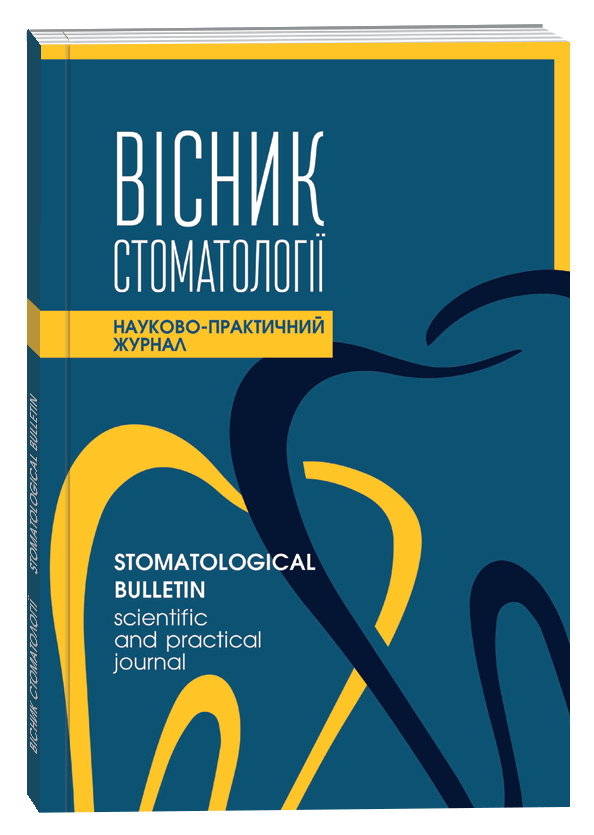WAYS OF COMPLEX TREATMENT OF ACQUIRED MAXILLOMANDIBULAR ANOMALIES ON THE BACKGROUND OF ORAL HABITS
DOI:
https://doi.org/10.35220/2078-8916-2023-48-2.7Keywords:
Oral Habits, Cephalometry, Face, Orthodontic, DeformitiesAbstract
The aim of the study. Improving the quality of complex treatment in children with maxillomandibular anomalies on the background of oral habits. Research methods. We conducted clinical, radiological methods of examination of 60 patients 12–15 years old with acquired maxillomandibular anomalies and oral habits, 15 persons 12–15 years old without maxillomandibular anomalies and acquired deformities (norm group). We studied the data of computer tomograms, performed stereotopometric analysis (threedimensional cephalometry), determination of the thickness of the masticatory muscles in symmetrical areas of the face. All patients had complex treatment with the use of myofunctional devices (Myobrace, Froggymouth), fixed palatine devices (Hyrex, MARPE) and fixed orthodontic devices (bracket system, Tiger force devices and Carrire Motion 3D).Statistical processing of the results was performed using a personal computer using the software package Statistica 12.0. Data distribution was assessed using the Kolmogorov-Smirnov test of normality. Mean values and standard errors were calculated for continuous variables. Correlation between parameters was analyzed using Spearman’s correlation coefficient and tested for significance. Significance was set at p<0.05. Scientific novelty. Clinical examination showed that oral habits were manifested in 96.6% of patients. The results of clinical and radiological examination, analysis of cephalometric parameters and data on the thickness of the masticatory muscles on symmetrical areas of the face confirm the relationship between chronic oral habits and formation of acquired maxillomandibular anomalies; confirm the presence of acquired rather than congenital deformity of the facial skeleton, which is associated with changes in the thickness of the masticatory muscles on the part of the deformation та compensatory muscle hypertrophy on the opposite side. After 12 months, the patients' cephalometric parameters differed significantly from the indicators before active orthodontic treatment and elimination of the oral habit, an increase in muscle thickness was observed in the areas where there was a chronic injury (p≤0.05). An increase in the thickness of the bone structure of the facial skull and an increase in the thickness of the masticatory muscles on the side where the oral habit was eliminated were observed. Conclusions. Oral habits progress regardless of the patient's age, they appear in 96.6% of patients in this group of patients. The results of clinical and X-ray research, analysis of cephalometric indicators and level of the thickness of the masticatory muscles confirm the relationship between a chronic oral habit and the development of the bone and muscle system. The obtained results indicate the ability of bone tissue to change its thickness and contours after eliminating the oral habit and confirm the presence of the functional matrix of bone structure development.
References
Вишемирська Т.А. Клініка, діагностика та лікування сагітальних аномалій прикусу у дітей з порушенням носового дихання: дис. ... канд. мед. наук: 14.00.21 «Стоматологія». Київ, 2022: 184 с.
Козляковський П. Загальна психологія: навчальний посібник у двох томах, T. 2. Mиколаїв, 2004: 240 с.
Наугольник Л. Психологія стресу. Львів: Львівський державний університет. 2015: 324 с.
Дорошенко С, Самойлік С. Поширеність зубощелепних аномалій у дітей віком 4-17 років. Сучасна стоматологія. 2020. № 5. С. 70-73.
Канюра О. Поширеність та структура зубощелепних аномалій у дітей (за матеріалами аналізу звернень за ортодонтичною допомогою) Проблеми військової охорони здоров’яю. 2014. № 1. С. 510-515.
Каськова Л, Марченко Л, Бережна О. Поширеність зубощелепних аномалій у дітей з урахуванням шкідливих звичок та відношення до ортодонтичного лікування. Вісник укранської стоматологічної академії. 2015. № 15(1). С. 17-20.
Фліс П, Ращенко Н, Філоненко В., Мельник А. Поширеність зубощелепних аномалій та мовленневихпорушень серед дітей віком 6-12 років. Сучасна стоматологія. 2018. № 4. С. 54-57.
Joelijanto R. Oral Habits That Cause Malocclusion Problems. IDJ. 2012. № 1(2). P. 88-93.
Hampton RS. Cultural changes in neural structure and function. 2018. № 3. P. 1-22. doi: 10.31234/osf.io/52eg.
Moss-Salentijn L. Melvin L. Moss and the functional matrix. Journal of Dental Research 1997. № 76. P. 1814-1817.
Oenning A, Jacobs R, Pauwels R, Stratis A, Hedeseu M, Salmon B Сone-beam CT in pediatric dentristy: DIMITRA project position statement. Pediatr. Radiol. 2018; 48: 308-316. doi: 10.1007/s00247-017-4012-9.
Pantus AV. Clinical evaluation of the fiber matrix application effectiveness during the guided bone regeneration of periodontal intraosseous jaw defects. DentscherWissenschaltsherold. – German Sciense Herald. 2019. № 1. P. 18-22.
Selin H, Davey G. Happiness across cultures: Views of happiness and quality of life in non-Western cultures. NY: Springer.2012;123. doi: 10.1007/978-94-007-270









